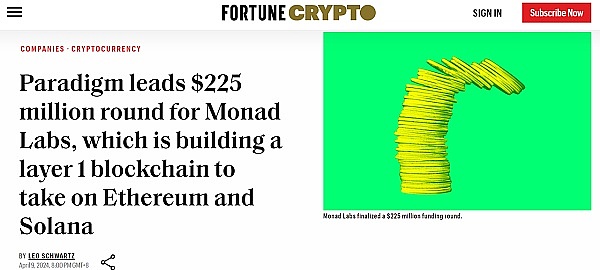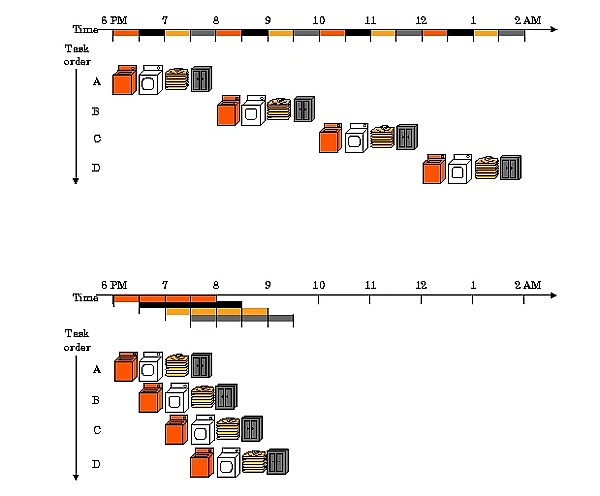Author: DeMan
Layer 1 blockchain Monad Labs announced the completion of $225 million in financing, led by Paradigm, with participation from Electric Capital, SevenX Ventures, IOSG Ventures and Greenoaks. The project intends to challenge competitors such as Solana and Sui. It is reported that this transaction is the largest cryptocurrency financing so far in 2024.

In this regard, Monad founder Keone Hon said that Monad's innovation comes from rebuilding Ethereum's blockchain from scratch, maintaining the ability to execute smart contracts while completing transactions at a faster speed, higher capacity and lower cost. Monad will fully support EVM.
Soon after, HTX Ventures announced a strategic investment in Monad Labs, and the cooperation between the two parties will promote innovation in the Web3 ecosystem.
The following will give readers a comprehensive introduction to the Monad project.
Anchoring the performance pain points of EVM, Monad has achieved 10,000+ TPS and has outstanding advantages in scalability
EVM has always been a pioneer in blockchain virtual machines and has become the most commonly used virtual machine over the years. It has witnessed famous innovations such as Curve, Uniswap and Maker. Despite the dominance of EVM, performance deficiencies have led to the rise of AltVM (alternative virtual machines). Among AltVM, Monad's advantages include 10,000 TPS on its mainnet and a strong community consensus culture.

It is reported that Monad will be officially launched later this year, and its goal is to become a highly scalable single large L1 blockchain. It is compatible with EVM and can handle more than 10,000 transactions per second with a block time of 1 second. This scalable performance is due to technologies such as parallel execution and Monad DB.
Monad achieves security and decentralization, and raised $19 million in a seed round of financing, led by Dragonfly, with participation from Placeholder, Shima Capital, Lemniscap, Cobie, etc.
Understand the parallelization technology logic of Monad and gain insight into the future evolution direction of the EVM L1 track
Monad is building a parallel EVM L1 with full bytecode compatibility. Monad is unique not only in its parallel engine, but also in the optimization engine they built at the bottom. Monad adopts a unique overall design approach that combines several key features such as pipelining, asynchronous I/O, consensus execution separation, and MonadDB.
A key innovation in Monad's design is pipelining with a slight offset. The offset allows more processes to be parallelized by running multiple instances simultaneously. Therefore, pipelining is used to optimize many functions such as state access pipelining, transaction execution pipelining, consensus and execution internal pipelining, and pipelining within the consensus mechanism itself.

Parallelization Technology Operation Diagram
Next, we will take a closer look at the parallelization part of Monad, which is also the technical core of the project.
In Monad, transactions are ordered linearly within the block, but the goal is to reach the final state faster by leveraging parallel execution. Monad's execution engine is designed with an optimistic parallel algorithm. Monad's engine processes transactions simultaneously and then performs analysis to ensure that the same results will be achieved if the transactions are executed one after another.
If there are any conflicts, they need to be re-executed. The parallel execution here is a relatively simple algorithm, but combining it with the other key innovations of Monad makes this approach novel. One thing to note here is that even if re-execution occurs, it is usually cheap because the inputs required by the invalid transaction are almost always kept in cache, so it will be a simple cache lookup. The re-execution is guaranteed to succeed because you have already executed the previous transactions in the block.
Monad also improves performance by separating execution and consensus (similar to Solana and Sei) and delaying execution. The idea is that if you relax the execution conditions so that the execution is completed before consensus is reached, the execution and consensus can be run in parallel, adding extra time to both. Of course, Monad handles this situation with a deterministic algorithm to ensure that one of them does not run too far and get out of control.
Two years in development and set to go live later this year, the Monad team story is also worth reading
Monad has been in development for about two years and was founded by Keone Hon, James Hunsaker, and Eunice Giarta. Keone and James are the two technical co-founders who worked together at Jump Trading for eight years.
Sitting on the same high-frequency trading desk, competing against 20 other teams inside Jump, Keone and James were able to come out on top for years in a row, facilitating over $10 trillion in notional volume per year and performing thousands of trades per second. At this level of volume, Keone and James experienced firsthand the difference microseconds can make in execution.
After entering the crypto space, Keone worked on Solana DeFi while James built Pyth. They began building Monad in 2022 after realizing that it was possible to implement a series of fundamental optimizations to the EVM that had become standard in high-performance computer science over the past 20 years, but had not yet been applied to the EVM. By introducing these components, a higher-performance EVM could be created that solves many of the current scaling bottlenecks.
 JinseFinance
JinseFinance
 JinseFinance
JinseFinance Alex
Alex JinseFinance
JinseFinance JinseFinance
JinseFinance JinseFinance
JinseFinance JinseFinance
JinseFinance JinseFinance
JinseFinance JinseFinance
JinseFinance JinseFinance
JinseFinance JinseFinance
JinseFinance